当前位置:
X-MOL 学术
›
Hydrol. Process.
›
论文详情
Our official English website, www.x-mol.net, welcomes your feedback! (Note: you will need to create a separate account there.)
A comparison of frameworks for separating the impacts of human activities and climate change on river flow in existing records and different near-future scenarios
Hydrological Processes ( IF 3.2 ) Pub Date : 2021-07-01 , DOI: 10.1002/hyp.14301 Soghra Andaryani 1 , Vahid Nourani 1 , James Ball 2 , Saeed Jahanbakhsh Asl 3 , Hamidreza Keshtkar 4 , Dennis Trolle 5
Hydrological Processes ( IF 3.2 ) Pub Date : 2021-07-01 , DOI: 10.1002/hyp.14301 Soghra Andaryani 1 , Vahid Nourani 1 , James Ball 2 , Saeed Jahanbakhsh Asl 3 , Hamidreza Keshtkar 4 , Dennis Trolle 5
Affiliation

|
Separating the effects of human activities/climate change on lotic ecosystems is one of the important components of environmental management as well as water resources maintenance. A Mann–Kendall analysis of hydro-climatic parameters and vegetation cover (VC), calculated using normalized difference vegetation index (NDVI), during the period 1985–2014 suggested a significant decrease and increase of river flow and temperature at p < 0.01, as well as an insignificant decline and increment of precipitation and VC, respectively within the arid and semi-arid region, that is, Zilbier River basin in north-western Iran. A separation of human activities/climate change effects on the reduction of river flow was carried out using three alternative approaches: a simple eco-hydrological method (coupled water-energy budget (ECH)), elasticity-based analysis (Budyko framework (EBA)), and a process-based watershed model based on the Soil and Water Assessment Tool (SWAT). The efficiency of these approaches was assessed over the periods 1985–1994, 1995–2014, and under five potential near-future human activities/climate change scenarios (S1–S5) by 2030. The results indicated that the climate change impacts on river flow was more severe than those of human activities. Climate change contributed to an average of 83.6% and 77.0% reduction in river flow in the past and the realistic future scenarios (i.e., S4 and S5), respectively, while human activities accounted for 16.4% and 30%. According to our findings, despite the fact that ECH results are more in line with the SWAT model, in case of physical characterization inaccessibility, ECH and EBA (as simple descriptive and quantitative models, respectively) can be used to separate, simulate and project the impacts of human activities and climate changes on river flow.
中文翻译:

比较现有记录和不同近期情景中人类活动和气候变化对河流流量影响的框架比较
区分人类活动/气候变化对水生态系统的影响是环境管理和水资源维护的重要组成部分之一。使用归一化差异植被指数 (NDVI) 计算的 1985-2014 年期间水文气候参数和植被覆盖 (VC) 的 Mann-Kendall 分析表明,在p < 0.01,以及在干旱和半干旱地区,即伊朗西北部的 Zilbier 河流域,降水和 VC 的下降和增加不显着。使用三种替代方法分离人类活动/气候变化对河流流量减少的影响:简单的生态水文方法(耦合水能预算(ECH))、基于弹性的分析(Budyko 框架(EBA)) ),以及基于土壤和水评估工具 (SWAT) 的基于过程的流域模型。这些方法的效率在 1985-1994 年、1995-2014 年期间以及到 2030 年的五种潜在的近期人类活动/气候变化情景(S1-S5)下进行了评估。结果表明气候变化对河流流量的影响比人类活动更为严重。在过去和现实的未来情景(即 S4 和 S5)中,气候变化分别导致河流流量平均减少 83.6% 和 77.0%,而人类活动分别占 16.4% 和 30%。根据我们的研究结果,尽管 ECH 结果更符合 SWAT 模型,但在无法获得物理表征的情况下,ECH 和 EBA(分别作为简单的描述性和定量模型)可用于分离、模拟和投影人类活动和气候变化对河流流量的影响。
更新日期:2021-07-21
中文翻译:

比较现有记录和不同近期情景中人类活动和气候变化对河流流量影响的框架比较
区分人类活动/气候变化对水生态系统的影响是环境管理和水资源维护的重要组成部分之一。使用归一化差异植被指数 (NDVI) 计算的 1985-2014 年期间水文气候参数和植被覆盖 (VC) 的 Mann-Kendall 分析表明,在p < 0.01,以及在干旱和半干旱地区,即伊朗西北部的 Zilbier 河流域,降水和 VC 的下降和增加不显着。使用三种替代方法分离人类活动/气候变化对河流流量减少的影响:简单的生态水文方法(耦合水能预算(ECH))、基于弹性的分析(Budyko 框架(EBA)) ),以及基于土壤和水评估工具 (SWAT) 的基于过程的流域模型。这些方法的效率在 1985-1994 年、1995-2014 年期间以及到 2030 年的五种潜在的近期人类活动/气候变化情景(S1-S5)下进行了评估。结果表明气候变化对河流流量的影响比人类活动更为严重。在过去和现实的未来情景(即 S4 和 S5)中,气候变化分别导致河流流量平均减少 83.6% 和 77.0%,而人类活动分别占 16.4% 和 30%。根据我们的研究结果,尽管 ECH 结果更符合 SWAT 模型,但在无法获得物理表征的情况下,ECH 和 EBA(分别作为简单的描述性和定量模型)可用于分离、模拟和投影人类活动和气候变化对河流流量的影响。


























 京公网安备 11010802027423号
京公网安备 11010802027423号